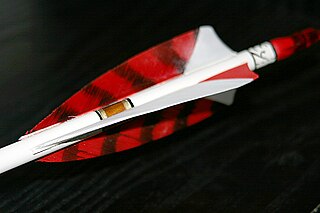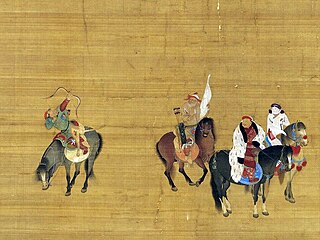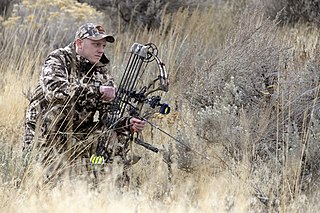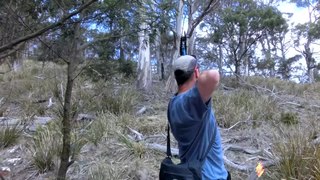
Archery is the sport, practice, or skill of using a bow to shoot arrows. The word comes from the Latin arcus, meaning bow. Historically, archery has been used for hunting and combat. In modern times, it is mainly a competitive sport and recreational activity. A person who practices archery is typically called an archer, bowman, or toxophilite.

An arrow is a fin-stabilized projectile launched by a bow. A typical arrow usually consists of a long, stiff, straight shaft with a weighty arrowhead attached to the front end, multiple fin-like stabilizers called fletchings mounted near the rear, and a slot at the rear end called a nock for engaging the bowstring. A container or bag carrying additional arrows for convenient reloading is called a quiver.

In modern archery, a compound bow is a bow that uses a levering system, usually of cables and pulleys, to bend the limbs. The compound bow was first developed in 1966 by Holless Wilbur Allen in North Kansas City, Missouri, and a US patent was granted in 1969. Compound bows are widely used in target practice and hunting.

Kyūdō is the Japanese martial art of archery. Kyūdō is based on kyūjutsu, which originated with the samurai class of feudal Japan. In 1919, the name of kyūjutsu was officially changed to kyūdō, and following the example of other martial arts that have been systematizing for educational purposes, kyūdō also reorganized and integrated various forms of shooting that had been used up until then. High level experts in kyūdō may be referred to as kyūdōka (弓道家)(Member of the Kyūdō family or house) and some practitioners may refer to themselves as yumihiki (弓引き), or 'bow puller'. Kyūdō is practised by thousands of people worldwide. The bow they use is called a yumi (弓), and the most common one has an asymmetrical shape of more than 2.0 metres, and is characterized by the archer holding the part of the bow below the center to shoot the arrow.

The bow and arrow is a ranged weapon system consisting of an elastic launching device (bow) and long-shafted projectiles (arrows). Humans used bows and arrows for hunting and aggression long before recorded history, and the practice was common to many prehistoric cultures. They were important weapons of war from ancient history until the early modern period, where they were rendered increasingly obsolete by the development of the more powerful and accurate firearms. Today, bows and arrows are mostly used for hunting and sports.

An arrowhead or point is the usually sharpened and hardened tip of an arrow, which contributes a majority of the projectile mass and is responsible for impacting and penetrating a target, as well as to fulfill some special purposes such as signaling.

Fletching is the fin-shaped aerodynamic stabilization device attached on arrows, bolts, darts, or javelins, and are typically made from light semi-flexible materials such as feathers or bark. Each piece of such fin is a fletch, also known as a flight or feather. A fletcher is a person who attaches fletchings to the shaft of arrows.
Darts are airborne ranged weapons. They are designed to fly such that a sharp, often weighted point will strike first. They can be distinguished from javelins by the presence of fletching and a shaft that is shorter and/or more flexible. Darts can be propelled by hand or with the aid of a hand-held implement such as a blowgun. They can be distinguished from arrows because they are not used with a bow.

The Mongol bow is a type of recurved composite bow historically used in Mongolia, and by the horse archers of the Mongol Empire. "Mongol bow" can refer to two types of bow. From the 17th century onward, most of the traditional bows in Mongolia were replaced with the similar Manchu bow which is primarily distinguished by larger siyahs and the presence of prominent string bridges.

Bowhunting is the practice of hunting game animals by archery. Many indigenous peoples have employed the technique as their primary hunting method for thousands of years, and it has survived into contemporary use for sport and hunting.

Howard Hill was an expert bowman who for over two decades, from the early 1930s into the 1950s, was often introduced or billed as "The World's Greatest Archer". He established the record for winning the most bow-and-arrow field tournaments in succession, a total of 196 competitions. In addition, Hill served as a supporting actor, trick-shot performer, and technical adviser on archery for Hollywood shorts and feature films. He also produced and directed documentaries and instructional films on bowhunting, and in the 1950s published two books on the subject, Hunting the Hard Way and Wild Adventure.

Target archery is the most popular form of archery, in which members shoot at stationary circular targets at varying distances. All types of bow – longbow, barebow, recurve and compound – can be used. In Great Britain, imperial rounds, measured in yards, are still used for many tournaments and these have slightly different rules to metric (WA) rounds, which are used internationally. Archers are divided into seniors and juniors, with juniors being those under the age of 21.

Field archery is any archery discipline that involves shooting at outdoor targets of varying and often unmarked distance, typically in woodland and rough terrain.

Popinjay or papingo, also called pole archery, is a shooting sport that can be performed with either rifles or archery equipment. The object of popinjay is to knock artificial birds off their perches. The rifle form is a popular diversion in Denmark; a Scottish variant is also known. The archery form, called staande wip in Dutch language and papegai in French, is popular in Belgium, and in Canada among descendants of 20th-century Belgian emigrants; it is shot occasionally in the United Kingdom under the governance of the Grand National Archery Society. In Germany a traditional shooting at wooden birds placed on a high pole is called "Vogelschießen". These are carried out either with small bore rifles or crossbows.
A bow draw in archery is the method or technique of pulling back the bowstring to store energy for the bow to shoot an arrow. The most common method in modern target archery is the Mediterranean draw, which has long been the usual method in European archery. Other methods include the pinch draw and the Mongolian or "thumb" draw. In traditional archery practice outside Western Europe the variations of the thumb draw are by far the most dominant draw types, with the Mediterranean draw restricted to the Olympic style of target archery.
This is a list of archery terms, including both the equipment and the practice. A brief description for each word or phrase is also included.

Clout archery is a form of archery in which archers shoot arrows at a flag from a relatively long distance and score points depending on how close each arrow lands to the flag.
Ya is the Japanese word for arrow, and commonly refers to the arrows used in kyūdō. Ya also refers to the arrows used by samurai during the feudal era of Japan. Unlike Western arrows, the ya is close to a metre long or longer. Traditional ya are made from natural materials, usually bamboo, while modern ones may use aluminium or carbon fiber.
Modern competitive archery involves shooting arrows at a target for accuracy and precision from a set distance or distances. This is the most popular form of competitive archery worldwide and is called target archery. A form particularly popular in Europe, North America, and South America is field archery, shot at targets generally set at various distances in a wooded setting. There are also several other lesser-known and historical forms, as well as archery novelty games.

In archery, a release aid, mechanical release, or release is a device that helps to fire arrows more precisely, by using a trigger to release the bowstring, rather than the archer's fingers. It is used to make the release of the bowstring quicker and reducing the amount of torque put onto the bowstring from the archer's fingers.
















